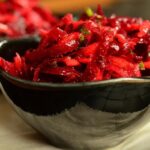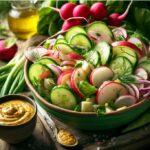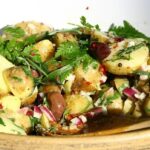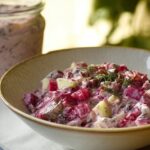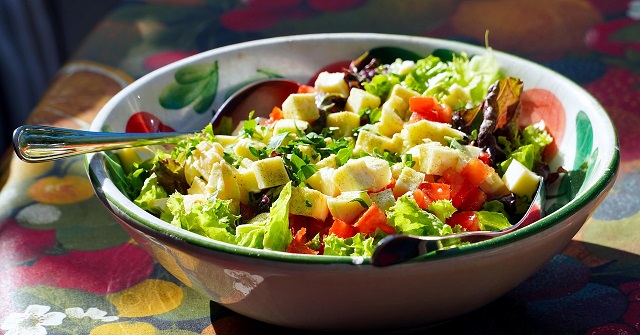
German salads are more than just side dishes – they are a flavorful glimpse into the country’s regional diversity and culinary history. Known for their bold dressings, fresh vegetables, and clever use of preserved ingredients, these salads appear at family dinners, festive gatherings, and even quick lunches across the country. Whether creamy, tangy, or sweet-sour, German salads showcase the cultural identity and regional pride of the people who make them.
This guide highlights 20 of the most popular German salad recipes. It’s the perfect starting point for discovering what makes these dishes both beloved and unique. From the ever-popular Kartoffelsalat to the lesser-known Pilzsalat, you’ll find a wide variety of recipes rooted in local traditions. Explore their stories, ingredients, and cultural significance below.
German Salad Recipes Overview
Salads in German cuisine cover a wide spectrum. They range from hearty to light, simple to complex, and often blur the lines between starter, side, and main dish. Some, like Gurkensalat, are ideal for summer picnics, while others, like Heringssalat, are steeped in festive traditions.
These salads also reflect Germany’s landscape and historical reliance on pickling, fermenting, and marinating. Many traditional recipes stem from a need to preserve seasonal harvests or extend the life of cured meats and fish. This practical origin evolved into dishes that are now staples of the German table.
German salads are especially prominent in regional cuisines. Bavaria favors vinegar-based potato salads, while the North tends toward creamy varieties with mayonnaise. Coastal regions feature seafood-heavy salads, and rural areas often incorporate ingredients like cabbage, sausage, and beets. Understanding German salads means engaging with the local tastes and customs that shape them.
Related Topics
1. Kartoffelsalat (German Potato Salad)
The quintessential German salad with multiple regional versions. Southern styles use broth, vinegar, and onions, while Northern styles favor mayonnaise and pickles.
2. Schwäbischer Kartoffelsalat (Swabian Potato Salad)
A vinegar-and-broth-based potato salad from the Swabia region. Served warm and known for its simplicity and bold flavor.
3. Gurkensalat (Cucumber Salad)
Thinly sliced cucumbers dressed with vinegar, sugar, dill, and sometimes sour cream. A staple summer side dish throughout Germany.
4. Rotkohlsalat (Red Cabbage Salad)
This vibrant salad is made with shredded red cabbage, vinegar, apples, and sometimes spices like cloves and cinnamon. It pairs well with roast meats.
5. Krautsalat (German Coleslaw)
White cabbage salad made with vinegar and sugar. Some versions include bacon for added richness. Served with schnitzel or grilled sausages.
6. Wurstsalat (Sausage Salad)
A Bavarian and Swabian favorite. Made with sliced sausage, onions, and pickles in a tangy vinaigrette. Often enjoyed with rye bread and beer.
7. Fleischsalat (Meat Salad)
A deli-style salad made from finely chopped bologna-type sausage and gherkins in a creamy mayonnaise dressing. Served on bread or as part of a cold platter.
8. Heringssalat (Herring Salad)
A festive salad featuring marinated herring, beets, potatoes, apples, and onions. Common during the Christmas and New Year season.
9. Matjessalat (Matjes Herring Salad)
A softer and sweeter version of herring salad using young herring (Matjes). Mixed with apples, onions, and sour cream.
10. Bohnensalat (Green Bean Salad)
Blanched green beans dressed with mustard vinaigrette and onions. Sometimes enhanced with bacon or hard-boiled eggs.
11. Linsensalat (Lentil Salad)
Hearty and healthy, lentils are tossed with vinegar, herbs, and vegetables. A great make-ahead salad for buffets and work lunches.
12. Tomatensalat (Tomato Salad)
Fresh tomatoes with onions, vinegar, and oil. Often garnished with parsley or basil. Refreshing and quick to prepare.
13. Eiersalat (Egg Salad)
Hard-boiled eggs chopped and mixed with a mustard-mayo dressing. A popular sandwich filler or part of a cold meal spread.
14. Spargelsalat (Asparagus Salad)
White asparagus in season is lightly cooked and mixed with vinaigrette or creamy sauce. Sometimes paired with ham or eggs.
15. Sauerkrautsalat (Raw Sauerkraut Salad)
A crunchy salad made with unpasteurized sauerkraut, grated carrots, apples, and onions. Rich in probiotics and flavor.
16. Pilzsalat (Mushroom Salad)
Button or wild mushrooms marinated in vinegar and herbs. Served cold, often with rye bread. A rustic dish with strong flavors.
17. Rindfleischsalat (Beef Salad)
Cooked beef slices with onions, mustard, and pickles in a tangy dressing. Great as a cold lunch or hearty starter.
18. Rote-Bete-Salat (Beetroot Salad)
Beets are boiled, sliced, and dressed with vinegar and oil. Sometimes includes horseradish or apples for sweetness.
19. Gemischter Salat (Mixed Green Salad)
A combination of lettuce, shredded carrots, cabbage, and radishes. Common in restaurants as a default starter.
20. Obstsalat mit Quark (Fruit Salad with Quark)
A sweet and creamy dessert salad made with fresh seasonal fruit and Quark cheese. Often served as a light finish to a meal.
Cultural Significance or Practical Applications
German salads are not only about flavor but also about cultural practices. Many of them developed as a response to seasonal availability and food preservation needs. In rural communities, cabbage and root vegetables were turned into long-lasting side dishes. In port towns, pickled fish became a delicacy that shaped celebratory dishes.
They also serve practical roles in modern diets. High in vegetables, fiber, and often protein, German salads offer a balanced meal or side. They are served year-round – cold in summer, with warm elements in winter – and are found at everything from casual barbecues to formal feasts.
During Christmas and Easter, salads like Heringssalat or Fleischsalat take center stage. At beer gardens, potato and sausage salads are served as traditional fare. In schools and canteens, simpler versions like mixed greens and cucumber salad appear regularly.
Moreover, many salads are passed down in families, making them a cornerstone of culinary heritage. Recipes are often adjusted to suit taste, region, or occasion, keeping the tradition alive and evolving.
German salads are deeply woven into the country’s culinary and cultural fabric. From humble lentil dishes to elegant herring creations, they offer a blend of history, practicality, and taste. Each salad tells a story – of a region, a season, or a family tradition.
Explore our authentic recipes for German salads and dive into the cultural richness behind each dish. Want to try your hand at a creamy Kartoffelsalat or a bold Rotkohlsalat?
Visit our recipes at GermanCulture.com.ua to discover detailed instructions and cultural background for each salad. Let your journey into German cuisine start with a forkful of tradition.
